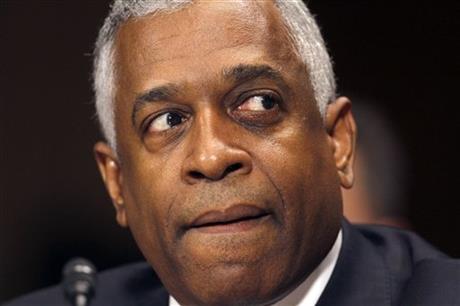
By ALICIA A. CALDWELL
FILE – In this June 11, 2013, file photo B. Todd Jones of Minnesota, President Barack Obama’s nominee for director of the Bureau of Alcohol, Tobacco, Firearms and Explosives (ATF), testifies at his nomination hearing on Capitol Hill in Washington. To the committee Jones knowledge that the ATF is “very much in distress”. And repairing the agency, which is still boxed in by politics despite the gun debate, has not been easy for Jones so far. (AP Photo/Jacquelyn Martin, File)
WASHINGTON (AP) — When President Barack Obama picked B. Todd Jones to lead the Bureau of Alcohol, Tobacco, Firearms and Explosives, it looked like the moment had arrived when the beleaguered ATF would reassert itself as an agency with teeth.
It was January, and the nation was embroiled in a rare debate on gun control, the result of the massacre at a Connecticut elementary school the previous month. The White House pushed for tougher gun laws and Congress seemed unusually willing to consider them.
It didn’t work out that way.
One by one, the bills failed. Support for expanded background checks fizzled. Jones’ nomination sat idle for eight months before the Senate finally confirmed him.
Two months into his tenure, Jones is stuck between a White House with high expectations for curbing gun violence and a Congress that has little appetite for strengthening his agency.
“The debate going on in this town right now makes it real clear to anyone who’s got a mind and is forward-looking and not living day to day that the resources are going to be diminished,” Jones said. “We’re also going to have to and have been doing more with less. We’re not right-sized, we’re not resourced.”
The ATF is supposed to not only investigate gun crime but also inspect firearm dealers annually. But a recent internal report found the agency has nowhere near the manpower needed to conduct those inspections. More than half the nation’s gun dealers haven’t been inspected in the past five years.
There are 2,380 ATF agents, a number that’s remained relatively constant for more than a decade. One-fourth of those agents are eligible to retire this year.
Jones, 56, said he will push to expand hiring to bring in enough new agents in time to learn from those about to retire. Jones had been the agency’s acting director since 2011 and also was the U.S. attorney in Minnesota.
During his confirmation hearing, Jones acknowledged that ATF was “very much in distress.” Repairing that hasn’t been easy so far.
The ATF was among the many federal agencies rushing to the Washington Navy Yard last month when a Navy contractor killed 13 people and terrorized his office building with a sawed-off shotgun.
Tracing guns is the ATF’s responsibility. But in the first high-profile investigation since being confirmed, Jones saw the FBI snub his agents and trace the shotgun itself. Neither agency has commented on the situation.
Also, late last month the Justice Department’s inspector general issued a scathing report on the agency’s handling of cigarette smuggling cases between 2006 and 2011. The report concluded ATF mismanaged undercover operations, lost track of millions of cigarettes and misused some of the $162 million in profits from the investigations.
The conclusions recalled the missteps of the failed operation “Fast and Furious,” in which the ATF allowed gun-runners to buy weapons in hopes of tracking them and disrupting Mexican gun smuggling rings. The ATF lost track of the guns.
Jones joined the ATF as acting director in 2011, after the most egregious details of that operation came to light. He said he had no role in it.
Still, controversy over operation stalled his nomination. At his confirmation hearing, Sen. Charles Grassley, R-Iowa, said he wondered “why are we even here today?”
The legacy of “Fast and Furious” continues haunts the agency today, to Jones’ frustration.
“I’m tired of … constantly being flogged for mistakes,” he said. “There’s much, much more that we’ve done right that that public never hears about than the snafus that they do hear about.”
Nearly every field division leader has been replaced since Fast and Furious came to light. Jones said he’s refocusing its resources on where they’re needed the most.
Frank Surotchak, chief of ATF’s violent crime analysis branch, said his analysts merge gun-trace data with FBI crime statistics, which has helped agents focus some of the country’s roughest cities, including Stockton, Calif., and Camden, N.J.
While federal laws prevent ATF agents from using trace data alone to move to revoke a gun dealer’s license, the data can be used to build intelligence on potential criminal gun dealers.
Jones said he’s also made less noticeable internal policy changes, including launching what he describes as a new business model dubbed “Frontline.” It is intended to find gaps that allow lawfully purchased guns to end up on the black market.
He said that’s the agency’s “sweet spot” and he wants his agents getting back to that fundamental mission.
__



